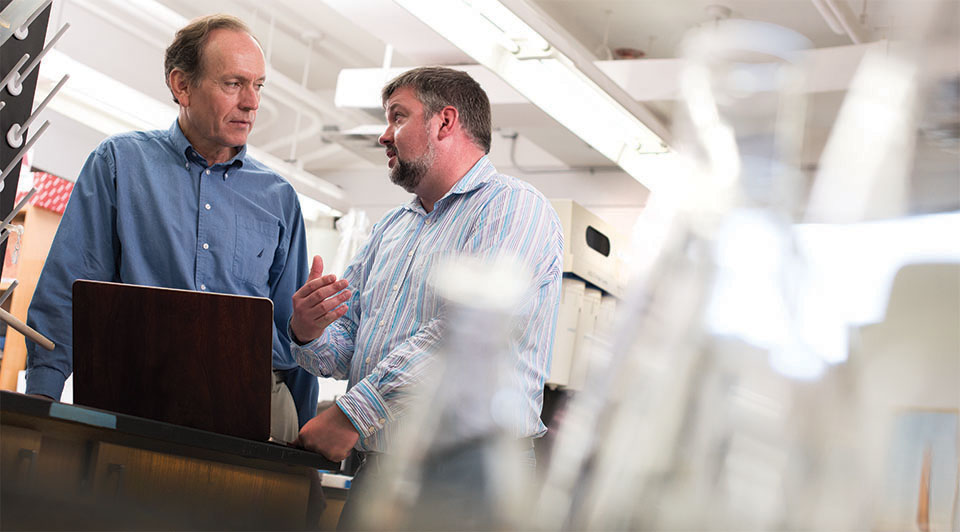Around 40 million people worldwide live with HIV. The Centers for Disease Control estimates that 50,000 people in the U.S. are newly infected with HIV each year. UMKC Associate Professor of Biological Sciences Thomas Menees, Ph.D., and Professor of Biological Sciences Gerald Wyckoff, Ph.D., are trying to find out how to stop the virus in its tracks.
One day last spring, Thomas Menees helped a colleague by presenting, on short notice, at the weekly School of Biological Sciences seminar series.
Menees is a molecular biologist who studies elements crucial to the propagation of retroviruses. HIV, the virus that causes AIDS, is a classic example of a retrovirus. Upon cellular infection, these viruses convert their viral RNA into DNA and then insert this newly copied molecule into the host cell’s DNA. As long as the cell is alive, it is now a source of new virus. HIV’s ability to hijack genetic material and use it to replicate is one of the reasons it eludes a cure.
At the seminar, Menees explained his efforts to better understand the role a particular enzyme plays in the lifecycle of retroviruses. As he spoke, he noticed Gerald Wyckoff, an evolutionary biologist in the School of Biological Sciences, seemed to be paying especially close attention.
Wyckoff was intrigued, and as he continued to listen, he saw the potential for collaboration.
What Wyckoff brings to the partnership is a powerful computational discovery tool, developed during his research on the evolution of gene sequences.
“Just out of necessity, when you are looking at large numbers of genes, you have to have a way of organizing them,” he says. “Early on, I was building simulations and tools that would allow me to simultaneously look at hundreds of genes from an evolutionary perspective.”
Together, the scientists are using traditional bench science and computer programming to discover a potential new therapy for treating HIV. The target for the new therapy is an enzyme Menees has studied for 20 years. In the lab, Menees looks for chemical compounds that can deactivate the enzyme, rendering retroviruses inactive. Wyckoff runs the lead drug candidates through his software to find real and theoretical compounds with similar characteristics.
Using a conventional approach, Menees has screened several thousand compounds over a period of two years. Wyckoff’s virtual system can screen millions in a short time.
“You always need to prove this stuff at the bench,” Wyckoff says. “But I can do a lot of stuff in silico — computationally — that we really could have only dreamed about 20 years ago.”
Menees and Wyckoff are not the only ones excited by what they might be able to accomplish working together. In 2015, they received a grant from the University of Missouri System Office of Research and Economic Development designed to “fast track” research with commercial potential.
The struggle to find a vaccine or cure is partly a function of HIV’s unreliable replication system. Researchers talk about the virus being “sloppy” when it converts its RNA into DNA in a host cell. “It makes a mistake almost every single time it copies its genome,” Menees says.
For a virus, sloppiness is virtue. HIV turns its knack into making defective copies of itself into an advantage.
“In the early stages of an infection, you mount a strong immune response to the virus,” Menees says. “But it’s always behind, because the virus is always undergoing changes, and the changed forms are the ones that end up replicating the most, because they’re not being inhibited by our immune response. It’s always staying ahead of us.”
The virus’ ability to outrun the body’s immune response is one of the reasons why an individual infected with HIV frequently needs to change drug regimens. Many HIV patients take a drug cocktail to avoid creating strains of the virus immune to single drugs.
HIV’s slippery nature has led Menees to focus on the way humans react to it. Viruses, he notes, depend on their host cells for many basic functions.
“Our idea was to find some novel type of host dependency — something someone hadn’t described before — and figure out how that works and how broadly it’s distributed among this class of viruses,” he says.
Menees uses lowly baker’s yeast in his research. The organism is popular with scientists because many of the processes that drive the biology of a baker’s yeast cell are the same processes that drive a human cell. Its genome is also easy to manipulate — another plus.
Using yeast, Menees studies the cell material important for the propagation of retroviruslike elements. He is particularly interested in Dbr1, a debranching enzyme involved in RNA processing.
In 2004, Menees and a co-author published a paper in Science suggesting that Dbr1 played a previously undescribed role in HIV replication.
The idea met with resistance and continues to remain controversial. Menees, however, is confident the discovery is real. He says he’s spent the past three years looking directly at the question of whether the structure described in the Science paper exists.
“The data’s beautiful,” he says.
Scientists may not agree on the particulars, but it’s accepted that Dbr1 plays a role in reverse transcription, the process by which a retrovirus commandeers the DNA of a host cell. A group of existing HIV drugs target the reverse transcription step. But almost all of them target the HIV reverse transcriptase enzyme, either directly or by giving it bogus material to use.
“The problem is, they work very well until they don’t, and the reason they don’t is because of drug resistance,” Menees says.
Menees and other researchers are hopeful about Dbr1 because it’s a human enzyme and, therefore, a more stable target than the sloppily mutating virus itself.
“Our enzymes are nowhere near as error-prone,” Menees says. “We could never have the error rate of HIV or we’d never get from a single cell up to a developed adult or child.”
Wyckoff agrees: “We’re pretty static. HIV? Not so much.”
Every few months, Menees travels to Stanford University to look for compounds that inhibit Dbr1.
At Stanford, Menees uses high-throughput screening technology to analyze thousands of small molecules at the same time. The cells are genetically engineered to produce a simple readout under a microscope: bright green fluorescent spots indicate a positive for inhibition of Dbr1.
When Menees returns, Wyckoff runs the good leads through three different software programs. Wyckoff says his computational methods tease out a “fine-grain analysis” of the compounds that look like likely inhibitors. In drug development, this step is known as “hit expansion,” a process of searching for compounds with similar structures.
Wyckoff’s tools allow the researchers to expand their search into a theoretical realm.
“If all you can do at the bench is test the stuff you’ve got, you’ll never see the stuff that hasn’t been created,” Wyckoff says. “The ability to search through compounds that are not immediately available to you means you can spend your money a lot more effectively.”
If the compound looks promising but doesn’t exist, Menees and Wyckoff work with a chemist to synthesize it.
To date, the researchers have identified a dozen compounds that merit further study. Menees says he’s being “very picky.”
“The best compounds are still in front of us,” he says.
Menees and Wyckoff are focused on the practical aspects of their work. If they can identify a compound that inhibits Dbr1 in a living cell, they plan to pursue intellectual property development through invention disclosure and perhaps patent application, if appropriate.
As it stands, only one drug on the market targets the human response to the HIV virus, the path Menees and Wyckoff are taking in their research. Sold by Pfizer under the brand name Selzentry, the drug, maraviroc, blocks an important receptor.
HIV drugs constitute a $14 billion market, which Menees says reflects the staggering number of people with HIV as well as the limitations of existing drug therapies.
“We need to have ways to treat people so they can live full, productive lives and not constantly have T-cells crashing and having to switch therapies,” Menees says.
Unraveling the mysteries of Dbr1 may open doors beyond HIV. Wyckoff sees potential for treating other retroviral infections, including those that affect other species, such as the feline leukemia virus, which causes cancer and other health problems in cats.
The scientists, who have taken courses in entrepreneurship through the Ewing Marion Kauffman Foundation, do not want to limit the possibilities of a collaboration born from the humble beginnings of a hastily arranged seminar.
As Wyckoff says, “You have to follow your nose, right?”

